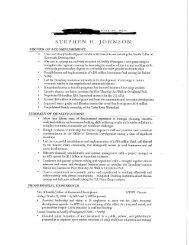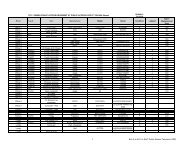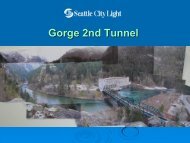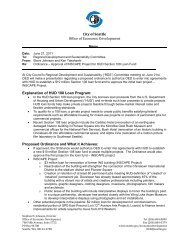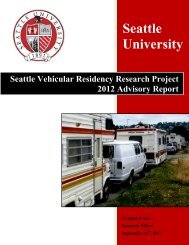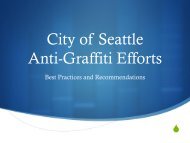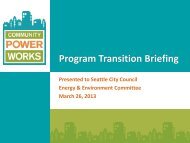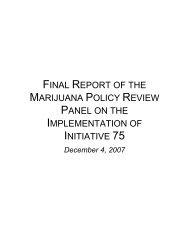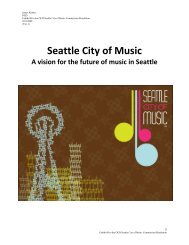2013 Water System Plan, Volume II - Seattle City Clerk's Office - City ...
2013 Water System Plan, Volume II - Seattle City Clerk's Office - City ...
2013 Water System Plan, Volume II - Seattle City Clerk's Office - City ...
You also want an ePaper? Increase the reach of your titles
YUMPU automatically turns print PDFs into web optimized ePapers that Google loves.
B. SYSTEM RELIABILITY ANALYSIS<br />
Hydraulic modeling of various scenarios is an effective way to evaluate current and<br />
future storage requirements for a complex system such as SPU’s. Scenarios representing<br />
peak and off-peak demand seasons, as well as a range of emergency conditions, provide<br />
the basis for the analysis. SPU has analyzed its entire system to ensure that there is<br />
adequate storage to maintain continuity of retail and wholesale service in the future for<br />
certain emergencies with current and planned facilities in service or decommissioned.<br />
Under certain emergency scenarios and during periods of higher than average demands,<br />
SPU would aggressively message to retail and wholesale customers to reduce water use<br />
to indoor-use levels within 12 to 24 hours.<br />
While the storage facilities are periodically removed from service for maintenance such<br />
as cleaning, the analyses assume all available storage facilities for that scenario are in<br />
service. Such maintenance outages slightly increase the water supply risk, but SPU<br />
mitigates this risk by scheduling the larger reservoirs for cleaning during the off-peak and<br />
shoulder seasons, and by taking only one large reservoir out of service at a time, if<br />
possible. Additionally, the frequency of reservoir cleaning is now lower than in the past<br />
because of filtration on the Tolt supply and covering of the reservoirs. <strong>Plan</strong>ned outages<br />
of other major facilities are also scheduled to reduce risks to the water supply whenever<br />
possible.<br />
SPU has identified specific emergency scenarios that are appropriate for its system.<br />
These scenarios represent abnormal operating conditions associated with unscheduled<br />
power outages and facility failures, but without specific identification of the root cause of<br />
the outage or failure, although examples are provided for some scenarios. The scenarios<br />
analyzed could be caused by natural events such as severe weather storms or earthquakes,<br />
intentional or unintentional actions by humans (e.g., vandalism), or failure of a facility<br />
component due to age or other cause. Extreme events that may cause more than one<br />
scenario to occur concurrently are not considered because these have a very low<br />
probability of occurrence and system performance is very difficult to predict. There are<br />
three types of emergency scenarios that are used:<br />
1. Transmission pipeline outages<br />
2. Source water treatment facility outages<br />
3. Regional power failure affecting all six individual pumped zones<br />
1. Transmission Pipeline Outages<br />
Transmission pipeline outages were analyzed in detail in the mid-1990s <strong>System</strong> Storage<br />
and Reliability Analyses (SSRA) where specific emergency scenarios were defined, each<br />
involving at least two system components serving a certain part of the system being<br />
unavailable. (For more details on the SSRA please refer to SPU’s 2007 WSP.) Through<br />
detailed modeling it was demonstrated that retail and wholesale service can be<br />
maintained at average day demand levels which were much higher in the mid-1990s than<br />
they are now for at least seven days, which is a little more than twice the expected 3-day<br />
maximum repair time for any large pipeline break. (The 3-day maximum repair time is<br />
part of SPU’s wholesale continuity of service level of service and is based in part on<br />
-2-



